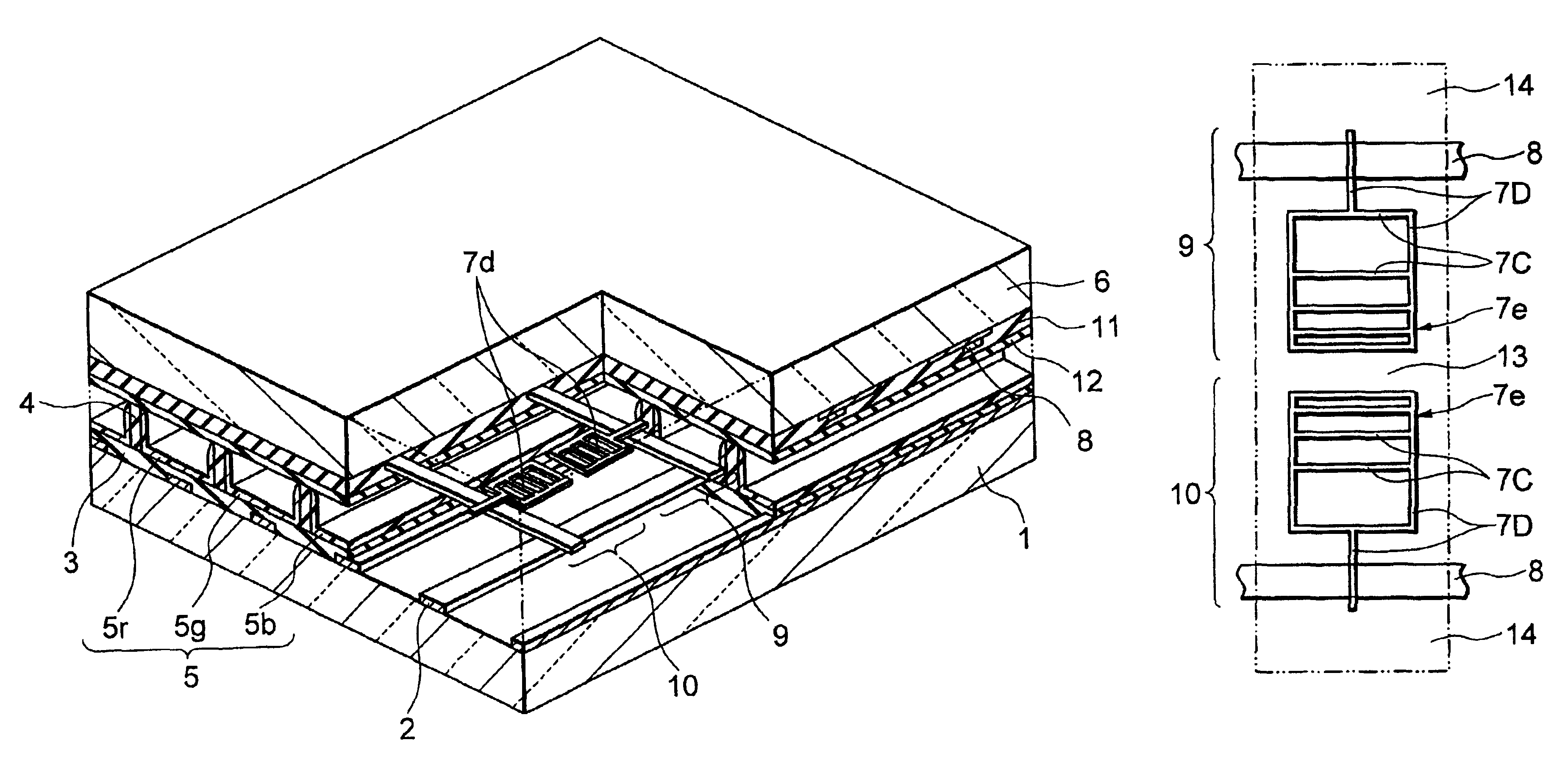Plasma display panel having an improved plane electrode structure
a technology of electrode structure and display panel, which is applied in the manufacture of electrode systems, electrode discharge tubes/lamps, and electrodes. it can solve the problems of increased heat generation of the panel, large power consumption, and large load on the drive circui
- Summary
- Abstract
- Description
- Claims
- Application Information
AI Technical Summary
Benefits of technology
Problems solved by technology
Method used
Image
Examples
embodiment 1
FIG. 7 is a partial cutout perspective view showing the constitution of a PDP according to a first embodiment of the present invention and FIG. 8 is a plan view showing a unit cell portion of said PDP.
In the PDP of the embodiment, a unit cell portion of the plane electrode consist of a plurality of thin wire electrodes 7A, which extend in the row direction and which are laid out at a constant interval from a discharge gap section 13 toward a non-discharge gap section 14 as shown in FIG. 8, where the left and right ends of these row direction thin wire electrodes 7A are connected with thin wire electrodes 7B that extend in the column direction to form horizontal slit-shaped plane electrodes 7d. The thin wire electrodes 7B that extend in the column direction from the center of the horizontal slit-shaped plane electrodes 7d and the bus electrodes 8 that extend in the row direction are connected to form a sustaining electrode pair (scan electrode 9 and common electrode 10).
The size of t...
embodiment 2
FIG. 11 is a plan view showing a unit cell portion of a PDP according to a second embodiment of the invention. The major difference of the second embodiment PDP in comparison with the first embodiment described above is that the plane electrodes are made into a vertical slit-shape.
More specifically, as shown in FIG. 11, a plurality of thin electrodes 7H extending in the column direction are laid out at a constant interval from the cell's vertical center axis toward the partition walls 4 and the upper and lower ends of these column direction thin wire electrodes 7H are connected by thin wire electrodes 7G that extend toward the row direction to form vertical slit-shaped plane electrodes 7g. The thin wire electrodes 7H that extend from the center of the vertical slit-shaped plane electrode 7g in the column direction and the bus electrodes 8 that extend in the row direction are connected to form a sustaining electrode pair (scan electrode 9 and common electrode 10).
The cell structure i...
embodiment 3
FIG. 14 is a plan view showing a unit cell portion of a third embodiment PDP of the invention. The major difference of the third embodiment PDP in comparison with the first embodiment described above is that the plane electrodes are made into a mesh-like shape.
More specifically, as shown in FIG. 14, a plurality of thin wire electrodes 7M extending in the row direction are laid out at a constant interval from a discharge gap section 13 toward a non-discharge gap section 14, and a plurality of thin electrodes 7N extending in the column direction are laid out at a constant interval from the cell's vertical center axis toward the partition walls 4. These row direction thin wire electrodes 7M and column direction thin wire electrodes 7N cross each other to form mesh-like plane electrodes 7j, and the thin wire electrodes 7N that extend from the center of the mesh-like plane electrodes 7j in the column direction and the bus electrodes 8 that extend in the row direction are connected to for...
PUM
 Login to View More
Login to View More Abstract
Description
Claims
Application Information
 Login to View More
Login to View More - R&D
- Intellectual Property
- Life Sciences
- Materials
- Tech Scout
- Unparalleled Data Quality
- Higher Quality Content
- 60% Fewer Hallucinations
Browse by: Latest US Patents, China's latest patents, Technical Efficacy Thesaurus, Application Domain, Technology Topic, Popular Technical Reports.
© 2025 PatSnap. All rights reserved.Legal|Privacy policy|Modern Slavery Act Transparency Statement|Sitemap|About US| Contact US: help@patsnap.com



